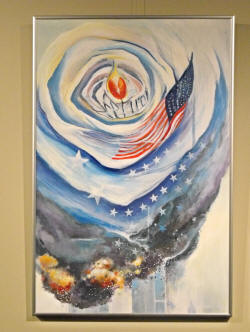 After college, Foo returned to Malaysia for a time, but eventually
he found himself back in the U.S., on the eastern seaboard,
perfecting his craft, teaching, writing two books and hosting
several solo art exhibits. After college, Foo returned to Malaysia for a time, but eventually
he found himself back in the U.S., on the eastern seaboard,
perfecting his craft, teaching, writing two books and hosting
several solo art exhibits.Foo has taken his art on multiple
occasions to Malaysia, Tanzania, Beijing, Singapore and Kenya, as
well as several noted U.S. galleries. He has also written two books
on his craft: "Paradise Regained," published in 2000, and "Poetic
Impulse and Fragrance of Spirituality," published in 2002.
In addition to all this, he has been an art educator in Trenton,
N.J.; Long Island, N.Y.; and Allentown, Pa.
Most art educators will tell their students that art is best
appreciated from a distance of at least 10 to 15 feet. For the
artistry of Foo, this is true, as from a distance his work reflects
brilliant colors and flowing shapes. Many of his pieces appear to be
landscapes, waterscapes or lovely, brightly colored gardens. At a
distance each work is a feast for the eye indeed.
But step in to within a foot or two of the paintings, and be
prepared for the hidden treasures that Foo subtly implants in each
work of art.

For example, this painting, entitled "Blue Falls at Sunrise,"
from a distance is clearly a flowing waterfall with a pair of cranes
standing at the base of the fall.
In the background the sun streaks the sky with brilliant orange
and yellow as it starts to peek over the horizon at the beginning of
a new day.

However, step in closer, and you'll find three lovely little
bluebirds hidden in the flowing waters.
Two are top center in the picture above, both facing the same
direction, but with the one on the left turning his head to look
back at his mate. Directly below the two and slightly to the left of
the white crane is a third, smaller bluebird, looking upward toward
the other two.
These little surprises are something that the observer will find
in virtually every painting Foo does. Hidden elements range from
birds to fish and butterflies, to lovely portraits of women.
Foo shared his technique, saying that his signature works start
with a wet canvas. He waters the canvas, then drops color onto it.
As the paint and water interact, the color flows around the canvas,
making its own shape and design.
Foo's talent comes in seeing what the flowing colors can become.
In the painting above, Foo saw flowing water and began there with
building the painting.
[to top of second column] |

At his exhibit at Lincoln College on Saturday afternoon, many of the
paintings were of Foo's signature style.
However, one stood out as being much different from
all the others.
While the painting is not whimsical, it is full of
symbolism and evokes a certain emotion for the viewer.
On Sept. 11, 2001, Foo was living just 50 miles from
the World Trade Center. He witnessed on television the plane
crashing into the second tower, and he knew that one of his very
best friends was inside that building.
Luckily, his friend was one of the few who were able
to escape before the towers came crashing down. But it moved Foo to
do a painting that would be a tribute to those who were lost.

At the base of the painting one can barely see the twin towers
engulfed in flames and smoke. As the smoke rises, the stars
implanted on the gray to white ribbons commemorate the souls lost
that day. The American flag symbolizes the patriotism of our
country. The white ribbons form a rose in remembrance, and in the
center of the rose is a broken heart.
In the guidebook for the exhibit, Debbie Ackerman,
the vice president for institutional advancement of Lincoln College,
wrote: "His paintings, full of glorious colors, seemingly shifting
shapes and gentle, flowing rhythms, reward the viewer who looks more
than once, as layer after layer of meaning is revealed deep beneath
their surfaces. In their complexity lies the simple peace and joy at
the heart of Hong's work and world."
Foo will be in Lincoln through the first of the
week. On Monday afternoon he will host a demonstration of his unique
technique at the new Lincoln Center.
[By NILA SMITH] |